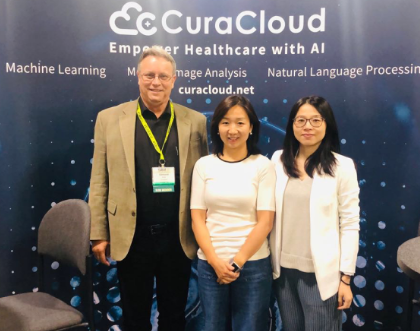By Ed Butler
For many of us in the medical imaging AI field, the annual gathering of the Society for Imaging Informatics in Medicine (SIIM) is one of the most important checkpoints in our year, along with RSNA and other specialty-oriented conferences. A checkpoint in computer processing is a snapshot of an application’s state that can be returned to when needed. The SIIM Annual Meeting is a useful checkpoint for comparing predicted trends with what has actually happened.
These snapshots from SIIM 2019 are a reminder of what life was like before the COVID-19 pandemic, when we could mingle with hundreds of colleagues in a ballroom and breathe the same air without being aware of that privilege. I, along with my colleagues, Xiaoxiao Liu and Xiuwen Yu, spent much of the 2019 conference in our booth on Startup Row. in 2020, we signed up for a regular booth, since after four years of successful growth we no longer considered CuraCloud a startup. We had looked forward to the venue in Austin, to nurturing existing friendships, and to building relationships for new collaborations.

Ed Butler, Xiaoxiao Liu, and Xiuwen Yu at SIIM 2019.
In my 2019 SIIM Report, I documented several trends, including:
- AI developer business models were evolving away from discrete apps to app platforms
- Healthcare organizations were deploying home-grown AI diagnostics without FDA review
- Federated learning models enabled AI models to be built across multiple enterprises
- Increasing interest in non-pixel data to provide context for medical image analysis
- FHIR and DICOMweb standards were becoming mandatory for AI applications
Due to the COVID-19 pandemic, SIIM 2020 is now a virtual event like many other conferences. Instead of a booth, we are now an event sponsor with a dedicated web page. The silver lining is that we able to take in a lot more of the sessions that we would not have been able to attend otherwise, and more of our scientific team will now be able to participate given the lower price and the fact they can attend remotely.
Our main goal at SIIM 2020 is to learn from the presentations and ideally use this opportunity to connect remotely with colleagues. I am curious about how the COVID-19 pandemic has changed the landscape for imaging informatics professionals. Clearly, our world has changed. Radiology practices, hospitals, and even large integrated delivery systems have experienced breath-taking revenue losses from the hiatus in elective procedures. Telemedicine has emerged as the new normal for primary care and specialty visits. The FDA has relaxed its oversight for some COVID-19 related in vitro diagnostics and software medical devices during the declared emergency. Federal bailout funds hardly make a dent in the budget shortfalls, resulting in widespread furloughs and layoffs of healthcare workers. And the second COVID-19 wave is beginning even before the first wave has gone.
How can imaging informatics come to the rescue? It is not enough to be cool, one must be truly useful. Medical imaging informatics can provide tools for radiology practice quality programs, although these are often not conducive to off-the-shelf products because—like data warehouses—they are driven by local reporting patterns and physician preferences that cannot be mandated across enterprises. Computer-aided triage algorithms can help prioritize worklists and may help patients, but are hard to justify in hard-dollar savings. Productivity improvements for the diagnostic radiology workflow can sometimes pay for themselves. Replacing surgical procedures with non-invasive radiological procedures can produce new revenues for radiology practices, but reduce surgical costs and revenues, which is a positive for population health but a negative for intervention revenues. It is all very exciting.
Which imaging informatics solutions create the most value? We’re looking forward to finding out what SIIM 2020 trends will become our next checkpoint.
This resource was first published prior to the 2020 rebranding of CuraCloud to Keya Medical. The content reflects our legacy brand.

Recent Comments